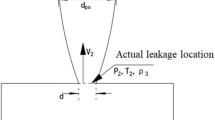This work is devoted to hydrogen safety security during severe accidents at NPP as well as the validation of equipment performance of passive safety systems under these conditions. The results of an experimental investigation of the performance of the primary means of measurement module of the hydrogen concentration control system under physicochemical actions on them due to the precipitation of insoluble aerosols, non-condensable gases, and oil vapor during severe accidents at NPP are presented. It is shown that the physicochemical actions do not significantly affect the performance of the primary means of measurement module of the hydrogen concentration control system.
Similar content being viewed by others
References
A. А. Fis’kov, V. V. Bezlepkin, S. E. Semashko, et al., “Impact of the precipitation of boric acid and its salts on the operability of passive safety systems during serious accidents in NPP,” At. Energ., 126, No. 2, 81–87 (2019); Atomic Energy, 126, No. 2, 88–95 (2019).
Description of Natural Circulation and Passive Safety Systems in Water Cooled Nuclear Power Plants, IAEA TECDOC-DRAFT, IAEA, Vienna (2004).
F. Payot, E. Reinecke, F. Morfin, et al., “Understanding of the operation behaviour of Passive Autocatalytic Recombiner (PRA) for hydrogen mitigation in realistic containment conditions during severe Light Water Nuclear Reactor (LWR) accidents,” Nucl. Eng. Des., 248, 178–196 (2012).
A. M. Bakhmetyev, M. A. Bolshukhin, V. A. Babin, et al. “Problems of the computational and experimental substantiation of the SPOT for a new generation of NPPs,” in: 5th Int. Sci. Techn. Conf. on Ensuring the Safety of NPP with VVER, May 29 – June 1, 2007, OKB Gidropress, Podolsk, Vol. 2, pp. 303–308.
V. N. Piskunov, Theoretical Models of the Kinetics of Aerosol Formation, VNIIEF, Sarov (2000).
V. A. Vasilenko, Yu. A. Migrov, V. K. Drought, et al., “The significance and place of the large-scale KMS stand in solving the safety problems of NPP with VVER,” At. Energ., 115, No. 4, 189–192 (2013); Atomic Energy, 115, No. 5, 224–227 (2014).
V. V. Bezlepkin, M. A. Zatevakhin, O. P. Krektunov, et al., “Experimental study of the system of heat removal from the volume of the containment shell at the SMK,” At. Energ., 115, No. 4, 197–201 (2013); Atomic Energy, 115, No. 5, 234–238 (2014).
A. A. Fis’kov, V. V. Bezlepkin, V. M. Pogrebenkov, et al., “Investigation of deposition of insoluble aerosols on the heat exchange surfaces of the passive heat removal system from the containment during accidents at nuclear power plants,” Tekhnol. Tekhnosf. Bezopasn., No. 1(83), 24–33 (2019).
A. A. Fis’kov, V. V. Bezlepkin, V. G. Kritskii, et al., “Investigation of changes in heat exchanger material properties as a result of aerosol deposition during a severe accident at a nuclear power plant,” At. Energ., 127, No. 4, 204–208 (2019); Atomic Energy, 127, No. 4, 222–227 (2019).
L. Bolshov and V. Strizhov, “SOKRAT – the system of codes for realistic analysis of severe accidents,” in: Proc. ICAPP’06, USA, June 4–8, 2006, Paper 6439.
Author information
Authors and Affiliations
Corresponding author
Additional information
V. M. Pogrebenkov is deceased.
Translated from Atomnaya Énergiya, Vol. 128, No. 6, pp. 310–315, June, 2020.
Rights and permissions
About this article
Cite this article
Fis’kov, A.A., Kritskii, V.G., Ditts, A.A. et al. Study on the Performance of Primary Means of Measurement of the Hydrogen Concentration During Severe Accidents at NPP. At Energy 128, 333–339 (2020). https://doi.org/10.1007/s10512-020-00696-2
Received:
Published:
Issue Date:
DOI: https://doi.org/10.1007/s10512-020-00696-2




